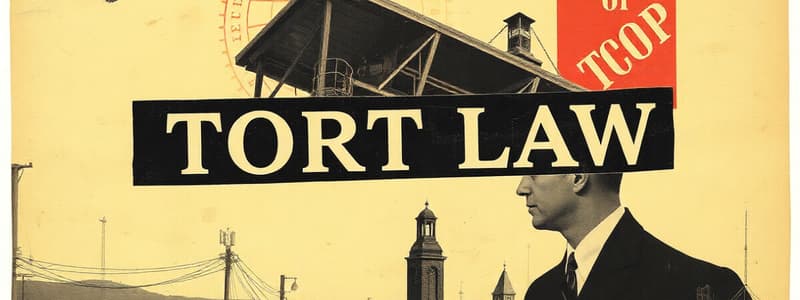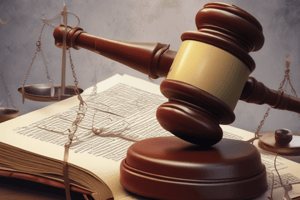Podcast
Questions and Answers
In jurisdictions adhering strictly to the principle of stare decisis within tort law, how would a court most likely address a novel claim lacking direct precedent, considering the historical evolution of tort law?
In jurisdictions adhering strictly to the principle of stare decisis within tort law, how would a court most likely address a novel claim lacking direct precedent, considering the historical evolution of tort law?
- Apply principles of equity to fashion a remedy, irrespective of established legal principles, to ensure fairness and justice in the specific case.
- Defer to legislative action, awaiting statutory guidance to address the novel issue and avoiding judicial lawmaking.
- Dismiss the claim outright, citing the absence of established common law precedent and adhering to a strict interpretation of existing statutes.
- Engage in a rigorous analysis of analogous cases, considering the broader societal needs and expectations that have historically driven the expansion of tort law. (correct)
Considering the modern shift in negligence jurisprudence, particularly the emphasis on establishing a duty of care, breach, and causation, how might a court approach a case where the harm was foreseeable, but the mechanism of injury was entirely novel and scientifically unpredicted?
Considering the modern shift in negligence jurisprudence, particularly the emphasis on establishing a duty of care, breach, and causation, how might a court approach a case where the harm was foreseeable, but the mechanism of injury was entirely novel and scientifically unpredicted?
- Allow the claim if a general duty of care can be established and the harm was a foreseeable consequence of the defendant's actions, regardless of the novelty of the injury mechanism. (correct)
- Reject the claim due to the lack of foreseeability regarding the specific mechanism of harm, adhering to a strict interpretation of proximate cause.
- Establish a special commission of scientific experts to determine whether the injury mechanism could have been predicted with reasonable scientific certainty at the time of the incident.
- Apply a risk-utility analysis, weighing the social value of the defendant's conduct against the risk of harm, considering the novelty of the injury mechanism as a factor mitigating the defendant's culpability.
In a complex tort case involving both intentional acts and negligence, each contributing independently to the final harm, how should a court determine liability and apportion damages among multiple defendants?
In a complex tort case involving both intentional acts and negligence, each contributing independently to the final harm, how should a court determine liability and apportion damages among multiple defendants?
- Apply the principle of joint and several liability, holding each defendant fully liable for the entire harm, regardless of their individual contribution.
- Apply a comparative negligence standard, reducing each plaintiff’s recovery by the degree to which their own negligence contributed to the harm, while holding defendants jointly and severally liable for the remainder.
- Apportion damages based on the relative culpability of each defendant, considering the nature of their actions (intentional vs. negligent) and the extent of their contribution to the harm. (correct)
- Hold only the defendant whose actions were the most immediate cause of the harm liable, absolving the others of responsibility.
How does the principle of the 'neighbour principle,' as articulated in Donoghue v Stevenson, influence the scope of duty of care in contemporary tort law, particularly in cases involving novel fact patterns and evolving social norms?
How does the principle of the 'neighbour principle,' as articulated in Donoghue v Stevenson, influence the scope of duty of care in contemporary tort law, particularly in cases involving novel fact patterns and evolving social norms?
In a scenario where a manufacturer adheres to all existing industry standards and regulatory requirements but its product still causes harm due to a latent defect undetectable through reasonable testing, how does strict liability apply?
In a scenario where a manufacturer adheres to all existing industry standards and regulatory requirements but its product still causes harm due to a latent defect undetectable through reasonable testing, how does strict liability apply?
Considering the historical evolution from intent-based torts to negligence-based liability, what philosophical shift does this represent in the legal system's approach to justice and accountability?
Considering the historical evolution from intent-based torts to negligence-based liability, what philosophical shift does this represent in the legal system's approach to justice and accountability?
In contemporary tort law, how do courts balance the need to provide remedies for harm with the potential for imposing excessive liability that could stifle innovation and economic activity?
In contemporary tort law, how do courts balance the need to provide remedies for harm with the potential for imposing excessive liability that could stifle innovation and economic activity?
How might the principles established in Langridge v Levy regarding misrepresentation and liability to third parties be applied in a modern context involving online product reviews and consumer reliance?
How might the principles established in Langridge v Levy regarding misrepresentation and liability to third parties be applied in a modern context involving online product reviews and consumer reliance?
Considering the principle of volenti non fit injuria (voluntary assumption of risk), how does it interact with the concept of duty of care in situations involving inherently dangerous activities?
Considering the principle of volenti non fit injuria (voluntary assumption of risk), how does it interact with the concept of duty of care in situations involving inherently dangerous activities?
In a scenario where a government entity undertakes a public works project, and despite exercising reasonable care, the project causes unforeseen damage to private property due to its inherent nature, what legal theories might govern the entity's liability?
In a scenario where a government entity undertakes a public works project, and despite exercising reasonable care, the project causes unforeseen damage to private property due to its inherent nature, what legal theories might govern the entity's liability?
Given the interaction between tort law and contract law, when does the 'economic loss rule' typically bar a negligence claim, and what are the key exceptions to this rule?
Given the interaction between tort law and contract law, when does the 'economic loss rule' typically bar a negligence claim, and what are the key exceptions to this rule?
In a scenario involving a complex product liability claim, where the plaintiff alleges a design defect made a product unreasonably dangerous, what evidentiary burdens and legal standards typically apply?
In a scenario involving a complex product liability claim, where the plaintiff alleges a design defect made a product unreasonably dangerous, what evidentiary burdens and legal standards typically apply?
How do courts typically distinguish between 'negligence per se' and ordinary negligence, and what are the implications for establishing breach of duty and causation?
How do courts typically distinguish between 'negligence per se' and ordinary negligence, and what are the implications for establishing breach of duty and causation?
Considering the evolving landscape of data privacy and security, how might traditional tort principles be applied to address harms resulting from data breaches and unauthorized disclosures of personal information?
Considering the evolving landscape of data privacy and security, how might traditional tort principles be applied to address harms resulting from data breaches and unauthorized disclosures of personal information?
In jurisdictions that have adopted comparative fault principles, how does 'pure' comparative fault differ from 'modified' comparative fault, and what are the key considerations for determining the plaintiff's recovery?
In jurisdictions that have adopted comparative fault principles, how does 'pure' comparative fault differ from 'modified' comparative fault, and what are the key considerations for determining the plaintiff's recovery?
Considering the intersection of tort law and intellectual property law, under what circumstances might a claim for 'tortious interference with contract' arise in the context of patent or copyright disputes?
Considering the intersection of tort law and intellectual property law, under what circumstances might a claim for 'tortious interference with contract' arise in the context of patent or copyright disputes?
In the context of tort law defenses, what is the difference between 'contributory negligence' and 'comparative negligence', and how has the latter evolved to address the perceived injustices of the former?
In the context of tort law defenses, what is the difference between 'contributory negligence' and 'comparative negligence', and how has the latter evolved to address the perceived injustices of the former?
In scenarios, how may claims be impacted via government regulations?
In scenarios, how may claims be impacted via government regulations?
Within the realm of products liability, what distinguishes a 'manufacturing defect' from a 'design defect', and how does this distinction influence the burden of proof?
Within the realm of products liability, what distinguishes a 'manufacturing defect' from a 'design defect', and how does this distinction influence the burden of proof?
Considering the defenses employed in tort law, how does 'assumption of risk' differ from 'contributory negligence', and how do these defenses impact the outcome of a tort claim?
Considering the defenses employed in tort law, how does 'assumption of risk' differ from 'contributory negligence', and how do these defenses impact the outcome of a tort claim?
Flashcards
What is a Tort?
What is a Tort?
A civil wrong that causes harm or loss, leading to legal liability.
Development of Tort Law
Development of Tort Law
Tort law evolves through judicial decisions and adapts over time to societal needs.
Levels of Fault in Torts
Levels of Fault in Torts
Harm caused by intentional acts, negligence, or strict liability.
Modern Shift: Negligence
Modern Shift: Negligence
Signup and view all the flashcards
Negligence Filled Gap
Negligence Filled Gap
Signup and view all the flashcards
What Isn't a Tort?
What Isn't a Tort?
Signup and view all the flashcards
What are Torts?
What are Torts?
Signup and view all the flashcards
What are Crimes?
What are Crimes?
Signup and view all the flashcards
Instigation & Carriage (Torts)
Instigation & Carriage (Torts)
Signup and view all the flashcards
Instigation & Carriage (Crimes)
Instigation & Carriage (Crimes)
Signup and view all the flashcards
Purpose of Torts
Purpose of Torts
Signup and view all the flashcards
Purpose of Crimes
Purpose of Crimes
Signup and view all the flashcards
Sanctions for Torts
Sanctions for Torts
Signup and view all the flashcards
Sanctions for Crimes
Sanctions for Crimes
Signup and view all the flashcards
Concept of Negligence
Concept of Negligence
Signup and view all the flashcards
Langridge v Levy, 1837
Langridge v Levy, 1837
Signup and view all the flashcards
Winterbottom v Wright
Winterbottom v Wright
Signup and view all the flashcards
George v Skivington, 1869
George v Skivington, 1869
Signup and view all the flashcards
Donoghue V Stevenson 1932
Donoghue V Stevenson 1932
Signup and view all the flashcards
Neighbour Principle
Neighbour Principle
Signup and view all the flashcards
Study Notes
- Tort originates from the French word for "wrong."
- In law, a tort is a civil wrong causing harm or loss, resulting in legal liability.
- Tort law has developed through judicial decisions, rather than statutes.
- Tort law was initially narrow but expanded to meet societal needs.
Levels of Fault in Torts
- Torts can involve intentional acts like battery or assault.
- Torts can arise from mere negligence, which is unintentional but careless harm.
- Torts can come from strict liability, where no fault is required, such as with dangerous activities.
- Legal recognition that harm can occur without intent has shifted the basis of torts.
- Courts inquire whether a "duty of care" existed, whether the duty was breached, and whether the breach caused harm.
- Lawsuits are now possible even without a contract or proven intent to harm.
- Negligence can lead to liability based on the "neighbour principle", reflecting societal demands for broader accountability.
What is Not Considered a Tort
- Not all wrongs are torts.
- Breach of contract is handled under contract law, not tort law.
- Moral wrongs lack legal remedy unless they also qualify as a tort.
- Crimes are prosecuted by the state, not private parties.
Torts vs. Crimes
- Torts involve a private individual (plaintiff) suing for compensation, while crimes involve the state prosecuting for violating public law.
- In torts, the victim or their representative brings the action, while in crimes, the government initiates the action.
- The standard of proof in torts is the balance of probabilities (>50% likely), while in crimes, it's beyond reasonable doubt (~99% certainty).
- The purpose of torts is to compensate the victim, while the purpose of crimes is to punish the offender and deter crime.
- Sanctions in torts include monetary damages and injunctions, while in crimes, they include jail time, fines, probation, and community service.
Key Takeaways on Torts and Crimes
- Torts involve civil wrongs with private lawsuits for harm.
- Crimes involve public wrongs with state prosecution for societal harm.
- Overlap between torts and crimes exists (e.g., assault), but procedures and goals differ.
Langridge v Levy, 1837
- A salesman sold a gun to the plaintiff's father, knowing it would be used by the plaintiff (the son).
- The seller falsely claimed the gun was well-made and the gun exploded injuring the son.
- The seller had liability because of international deceit, knowing the father was buying the gun for his son, the gun was faulty, and assured it was safe.
- The seller (defendant) was liable for damage to the son due to specific facts.
- The ratio decidendi is that a false representation made knowingly, resulting in harm to someone who acts on it, makes the representor responsible.
- Obiter Dictum : The court didn't confirm whether the action would be supportable if the plaintiff hadn't know of the false representation
Winterbottom v Wright, 1842
- The defendant leased a mail coach to the plaintiff's employer.
- The coach's axle was defective causing Winterbottom to be injured in a crash.
- Wright was accused of negligence for failing to maintain the mail coach.
- Winterbottom was employed by a third party with a contract with the Postmaster-General.
George v Skivington, 1869
- Joseph George bought hair wash from the defendant for his wife Emma, with the defendant’s representation it was fit for purpose.
- The defendant knew the hair wash was for Emma.
- The hair wash injured Emma.
- There was no contract between Emma and the defendant.
- A chemist is reliable for lack of skill and negligence, if he sells it for a particular purpose and knows the usage, causing injury.
- There's no need to prove that the chemist knew it was dangerous.
- "Negligence" can be substituted for "fraud," drawing analogy between Langridge v. Levy and this case.
Donoghue v Stevenson, 1932
- May Donoghue sued David Stevenson after consuming ginger beer containing a decomposed snail.
- The ginger beer came in a dark, opaque glass.
- Donoghue was shocked and became ill after consuming the drink and viewing the snail.
- Donoghue brought a civil action against the manufacturer despite no contract.
- An appeal succeeded setting a precedent for 'reasonable care'.
- Manufacturers have a duty of care to consumers for goods directly used by them.
- Failure to exercise reasonable care leads to liability.
- The manufacturer isn't absolved by the possibility of tampering with the product.
- Through obiter and past precedent, manufacturer duty to consumer is solidified.
Neighbour Principle
- One must take reasonable care to avoid acts that might foreseeably injure their "neighbour."
- A "neighbour" is defined as someone so closely and directly affected by your act that you reasonably contemplate them when acting.
- A manufacturer selling products in a way that shows intent to reach the ultimate consumer, without opportunity for examination, and with knowledge that a lack of care could cause injury, owes a duty to take reasonable care.
Studying That Suits You
Use AI to generate personalized quizzes and flashcards to suit your learning preferences.




